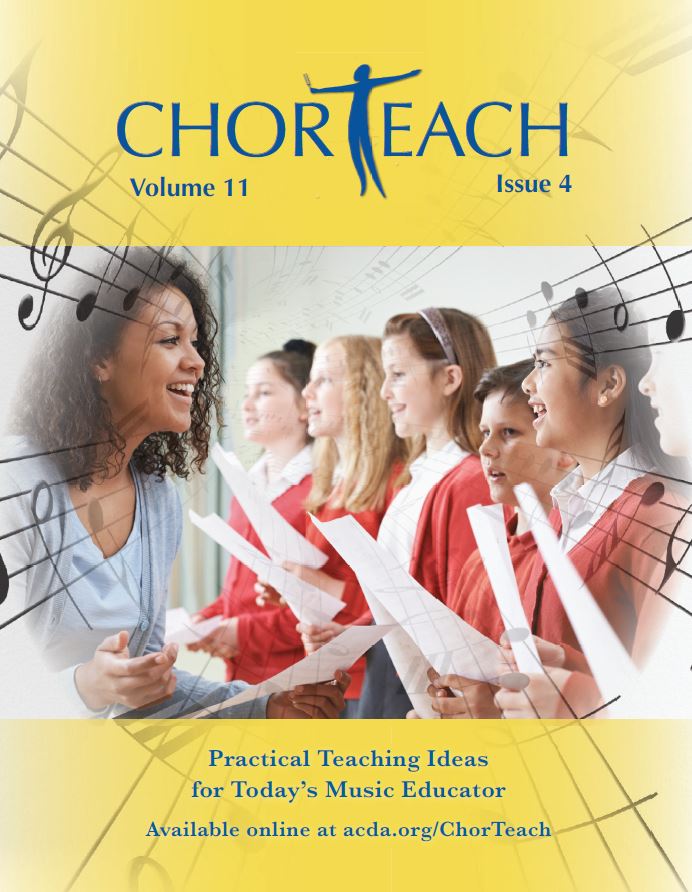
ChorTeach is ACDA’s quarterly online publication, designed for those who work with singers of all levels. A full annotated ChorTeach index is available online at acda.org/chorteach. Over 160 articles are organized into seventeen categories. For submission information, to view the index, or to read the latest issue, visit acda.org/chorteach.
Volume 11, Issue 4, is now available online and contains the following four articles:
Singing Seniors
Nicole Aldrich, Washington University, St. Louis, Missouri
“Older adults can bring a wealth of experience, wisdom, and grace to our ensembles. Along with these, they bring their older bodies and voices. And while the older adult voice is not the same instrument as the one the singer enjoyed in her or his younger years, it is simply not true that older adults should accept the voice changes as inevitable. Choral directors can do much to keep their “chronologically gifted” singers performing at a high level for years.
“Choir directors typically are most aware of the physical changes that singers undergo as they age because these changes have effects that we can hear in rehearsal: loss of vocal range, change in vibrato rate or size, loss of breath control, decreased endurance, pitch inaccuracies, breathiness, and changes in loudness, etc. Some of these physical changes include muscle wasting and related changes in balance, posture, and coordination, reduced vital capacity in the lungs, and stiffening, thinning and deterioration of the vocal folds which can cause the vocal folds to bow. Bowed vocal folds do not close as strongly. This can lead to breathiness, hoarseness, and vocal strain. Hearing loss, side effects from medications, and other health problems are also factors for some older adults.”
The Concert Spiritual—It is Closer to Western Classical Music than You Might Think
M. Roger Holland, University of Denver
“Most of us are aware of the origins of the Negro Spiritual. This folk music emerged in the crucible of American slavery when Africans were brought to the Americas in the seventeenth, eighteenth, and nineteenth centuries and labored under the harshest of circumstances. Infusing elements of their African culture along with Bible stories they learned from Christian missionaries, they sang about their present plight and desire for freedom. These “sorrow songs,” later called spirituals, became a huge part of what sustained the enslaved African community, gave them a sense of hope, and affirmed their humanity. The Negro Spiritual (or spiritual) is what musician and scholar Wendell Whalum refers to as the root and trunk of Black music.1
“After emancipation, many freed blacks wanted nothing to do with anything that was reminiscent of slavery and sought to divorce themselves of any vestiges of this terrible history, including the singing of spirituals, seeing this music as unsophisticated and an indication that one was uneducated.2 This mind-set no doubt contributed to the reluctance of the students at the Fisk Free Colored School (now Fisk University) to sing spirituals as they toured to raise money to support their school. Eventually, a small group of classically trained singers known as the Fisk Jubilee Singers embraced this folk music of their heritage and enthralled audiences worldwide.”
1 Wendell Phillips Whalum, “Black Hymnody,” Review & Expositor 70, no. 3 (Summer 1973): 353.
2 James Weldon Johnson. The Books of American Negro Spirituals. Vol. 1. (New York: Da Capo Press, Inc. 1989), 49.
Getting Inside the Mind of the Composer
Carl Ashley, First Baptist Church, Goldsboro, North Carolina
“Have you ever stopped to think about why composers compose? Many, if not most, of the great composers agree that composition cannot really be taught. Stravinsky once said, “A composer is or isn’t; he cannot learn to acquire the gift that makes him one… The composer will know that he is one if composition creates exact appetites in him, and if in satisfying them he is aware of their exact limits. Similarly, he will know he is not one if he has only a desire to compose or [a] wish to express himself in music.” (Conversations with Igor Stravinsky, by Robert Craft, n.p.)
“It is the performer’s responsibility to strive to recreate the composer’s intent. Composition is a form of artistic expression, just as performance is. If we do not fully understand the composer’s thoughts, we cannot fully understand his or her creation. One contemporary arranger once noted that she could only write down about ten percent of what was in her head. Because of this, some people claim that approaching a work from the perspective of the composer is impossible, since we can only have limited knowledge of the instrumentation, acoustics, or traditions of performance. In addition, our audience may come from a different background and culture, and not relying on the composer’s view gives the performer freedom. On the other hand, how can the music be truly appreciated unless it is performed as intended?”
The Missing Link: An Intermediate Step for Introducing New Music to Your Choir
Bo Shirah, McAllen High School, McAllen, Texas
Micah Bland, DMA Student, University of Southern California
“Since the time of early American singing masters who traveled from town to town selling their music books and teaching the public how to read music using a sol-fa system, the process of introducing and learning a choral work has seemed to remain relatively unchanged. Currently, two main approaches seem to dominate the secondary American educational system. The first being rote teaching, in which the teacher plays or sings the notes, with the students echoing until the content is learned. The second being a sight-reading method incorporating alternative syllables which represent a correlating pitch, such as solfege or numbers.
“It is in this second method that many educators approach the music learning process in a ritualistic fashion where students first count the rhythms, chant the solfege syllables in rhythm, and finally sing the syllables in rhythm. While this method is effective and utilized by many educators, there remains a missing step in this sequence of music teaching.”

+(1).gif)
Leave a Reply
You must be logged in to post a comment.